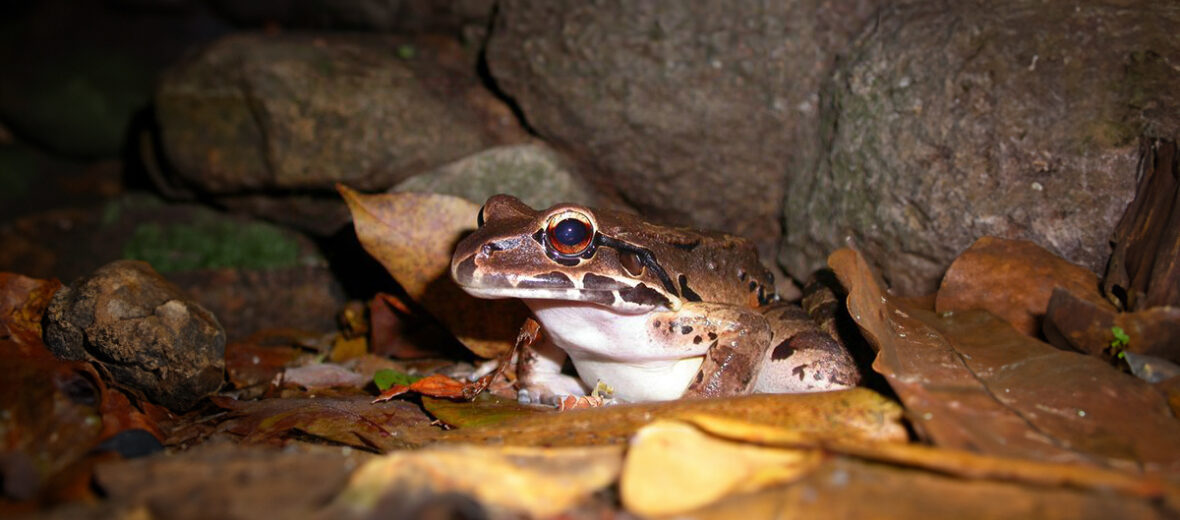
The mountain chicken, aka giant ditch frog, is native to the Caribbean islands of Montserrat and Dominica. However, barely any survive in the wild on Montserrat, and only a small population exists still in Dominica. These unfortunate amphibians face the threats of habitat loss and destruction at the hands of residential and commercial developments, agriculture, and logging; hunting; trapping; invasive species, and with them disease; volcanic activity; and climate change. The IUCN lists these frogs as Critically Endangered as well as Critically Depleted.
First the Stats…
Scientific name: Leptodactylus fallax
Weight: Up to 2.2 lbs.
Length: Up to 8 inches
Lifespan: Up to 12 years
Now on to the Facts!
1.) The survival of these large amphibians is dependent upon several breeding programs in numerous zoos around the world.
2.) Their populations decreased by up to 80% from 1995 – 2004!
3.) The primary reason for decline is attributed to hunting for human consumption as well as habitat loss.
4.) These frogs, like so many others are also affected by the deadly Chytrid fungus, aka Batrachochytrium dendrobatidis.
5.) They are also called crapaud. Which is just the French word for toad.
But wait, there’s more on the mountain chicken!
6.) The name mountain chicken is derived from the mountainous locales in which they live and the touting that they taste like chicken.
7.) These frogs prefer to dwell in dense secondary forests, scrub habitats, palm groves, hillside plantations, river valleys, ravines, and flooded forests near springs and streams.
Did you know…?
There were only an estimated 132 wild individuals remaining, as of 2017.
8.) Mountain chickens are terrestrial (spend their lives on the ground).
9.) They are also nocturnal (active at night), like most frogs.
10.) Being voracious predators, they prey on crickets, other various insects, millipedes, crustaceans, spiders (including tarantulas), other frogs, snakes, and small mammals like bats, mice, and young rats.
But wait, there’s still more on the mountain chicken!
11.) Unlike other frogs that breed in water, these critters breed in burrows up to 20 inches deep.
12.) During the breeding season, the males produce loud whooping calls and wrestle one another for breeding rights. The victorious male will retire to a burrow and make trilling barks to lure a potential female.
Did you know…?
After the tadpoles hatch, the female lays up to as many as 25,000 trophic (unfertilized) eggs for the sole purpose of tadpole food.
13.) After amplexus (where the male grasps the female for reproduction) is completed a foam nest is built, which takes up to 14 hours to finish. Then the male guards the nest as the female lays her eggs.
14.) Tadpoles take up to 45 days to develop.
15.) During the tadpole’s development, the female will continue to add to the foam nest to keep the tadpoles from desiccating (drying out).
But wait, there’s still a tad more on the mountain chicken!
16.) Only up to 43 froglets end up developing from the original egg mass.
17.) Females only produce 1 brood per season, however, the male frogs can father multiple broods with numerous females.
18.) Since the captive breeding effort based on the Montserrat population was started in 1999 by Jersey Zoo, these frogs have been successfully bred as part of an EEP breeding program involving more than 20 European zoos & 5 United States zoos, and viable clutches are produced each year to be reintroduced to the wild.
19.) In addition to the multiple ex situ (away from the original, natural, or appropriate position) breeding programs, since January 1998, the Montserrat Forestry and Environment Division, in partnership with Fauna & Flora International, have been monitoring their populations.
Now a Short Mountain Chicken Video!
Be sure to share & comment below! Also, check out the Critter Science YouTube channel. Videos added regularly!
Want to suggest a critter for me to write about? Let me know here.
Some source material acquired from: Wikipedia & IUCN
Photo credit: Gerardo Garcia



